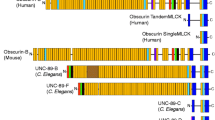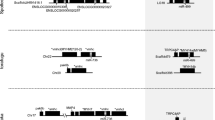Abstract
Myosin light chain kinases (MLCK) are a family of signaling proteins that are required for cytoskeletal remodeling in myocytes. Recently, two novel MLCK proteins, SPEG and obscurin-MLCK, were identified with the unique feature of two tandemly-arranged MLCK domains. In this study, the evolutionary origins of this MLCK subfamily were traced to a probable orthologue of obscurin-MLCK in Drosophila melanogaster, Drosophila Unc-89, and the MLCK kinase domains of zebrafish SPEG, zebrafish obscurin-MLCK, and human SPEG were characterized. Phylogenetic analysis of the MLCK domains indicates that the carboxy terminal kinase domains of obscurin-MLCK, SPEG and Unc-89 are more closely related to each other than to the amino terminal kinase domains or to other MLCKs, supporting the assertion that obscurin-MLCK is the vertebrate orthologue of Caenorhabditis elegans Unc-89, a giant multidomain protein that is required for normal myofibril assembly. The apparent lack of an invertebrate orthologue of SPEG and the conserved exon structure of the kinase domains between SPEG and obscurin-MLCK suggests that SPEG arose from obscurin-MLCK by a gene duplication event. The length of the primary amino acid sequence between the immunoglobulin (Ig) domains associated with the MLCK motifs is conserved in obscurin-MLCK, SPEG and C. elegans Unc-89, suggesting that these putative protein interaction domains may target the kinases to highly conserved intracellular sites. The conserved arrangement of the tandem MLCK domains and their relatively restricted expression in striated muscle indicates that further characterization of this novel MLCK subfamily may yield important insights into cardiac and skeletal muscle physiology.




Similar content being viewed by others
References
Aoki H, Sadoshima J, Izumo S (2000) Myosin light chain kinase mediates sarcomere organization during cardiac hypertrophy in vitro. Nat Med 6(2):183–188
Bagnato P, Barone V, Giacomello E, Rossi D, Sorrentino V (2003) Binding of an ankyrin-1 isoform to obscurin suggests a molecular link between the sarcoplasmic reticulum and myofibrils in striated muscles. J Cell Biol 160(2):245–253
Bang ML, Centner T, Fornoff F, Geach AJ, Gotthardt M, McNabb M, Witt CC, Labeit D, Gregorio CC, Granzier H, Labeit S (2001) The complete gene sequence of titin, expression of an unusual approximately 700-kDa titin isoform, and its interaction with obscurin identify a novel Z-line to I-band linking system. Circ Res 89(11):1065–1072
Benian GM, Tinley TL, Tang X, Borodovsky M (1996) The Caenorhabditis elegans gene unc-89, required for muscle M-line assembly, encodes a giant modular protein composed of Ig and signal transduction domains. J Cell Biol 132(5):835–848
Borisov AB, Raeker MO, Kontrogianni-Konstantopoulos A, Yang K, Kurnit DM, Bloch RJ, Russell MW (2003) Rapid response of cardiac obscurin gene cluster to aortic stenosis: differential activation of Rho-GEF and MLCK and involvement in hypertrophic growth. Biochem Biophys Res Commun 310(3):910–918
Borisov AB, Kontrogianni-Konstantopoulos A, Bloch RJ, Russell MW (2004) Dynamics of obscurin localization during myofibrillogenesis and remodeling in cardiac myocytes: obscurin as an integrator of sarcomere structure. J Histochem Cytochem (in press)
Hsieh CM, Fukumoto S, Layne MD, Maemura K, Charles H, Patel A, Perrella MA, Lee ME (2000) Striated muscle preferentially expressed genes alpha and beta are two serine/threonine protein kinases derived from the same gene as the aortic preferentially expressed gene-1. J Biol Chem 275(47):36966–36973
Kamm KE, Stull JT (2001) Dedicated myosin light chain kinases with diverse cellular functions. J Biol Chem 276(7):4527–4530
Kontrogianni-Konstantopoulos A, Jones EM, van Rossum DB, Bloch RJ (2003) Obscurin is a ligand for small ankyrin 1 in skeletal muscle. Mol Biol Cell 14(3):1138–1148
Russell MW, Raeker MO, Korytkowski KA, Sonneman KJ (2002) Identification, tissue expression and chromosomal localization of human obscurin-MLCK, a member of the titin and Dbl families of myosin light chain kinases. Gene 282(1–2):237–246
Small TM, Flaherty, Denise B, Mercer, Kristina B, Williams, Teresa M, Benian, Guy M, and Borodovsky, Mark (2002) A new isoform of UNC-89 with two MLCK-like protein kinase domains (abstract). In: East coast worm meeting, 14–16 June, Durham, N.H.
Soderling TR, Stull JT (2001) Structure and regulation of calcium/calmodulin-dependent protein kinases. Chem Rev 101(8):2341–2352
Sugden PH (2001) Mechanotransduction in cardiomyocyte hypertrophy. Circulation 103(10):1375–1377
Waterston RH, Thomson JN, Brenner S (1980) Mutants with altered muscle structure of Caenorhabditis elegans. Dev Biol 77(2):271–302
Young P, Ehler E, Gautel M (2001) Obscurin, a giant sarcomeric Rho guanine nucleotide exchange factor protein involved in sarcomere assembly. J Cell Biol 154(1):123–136
Acknowledgements
The authors would like to acknowledge Xiaoxia Wang for excellent technical assistance with the phylogenetic tree. This study was supported by funding from NIH 5R03 HD39693-02 to M.W.R.
Author information
Authors and Affiliations
Corresponding author
Additional information
Edited by D. Tautz
Rights and permissions
About this article
Cite this article
Sutter, S.B., Raeker, M.O., Borisov, A.B. et al. Orthologous relationship of obscurin and Unc-89: phylogeny of a novel family of tandem myosin light chain kinases. Dev Genes Evol 214, 352–359 (2004). https://doi.org/10.1007/s00427-004-0413-5
Received:
Accepted:
Published:
Issue Date:
DOI: https://doi.org/10.1007/s00427-004-0413-5




